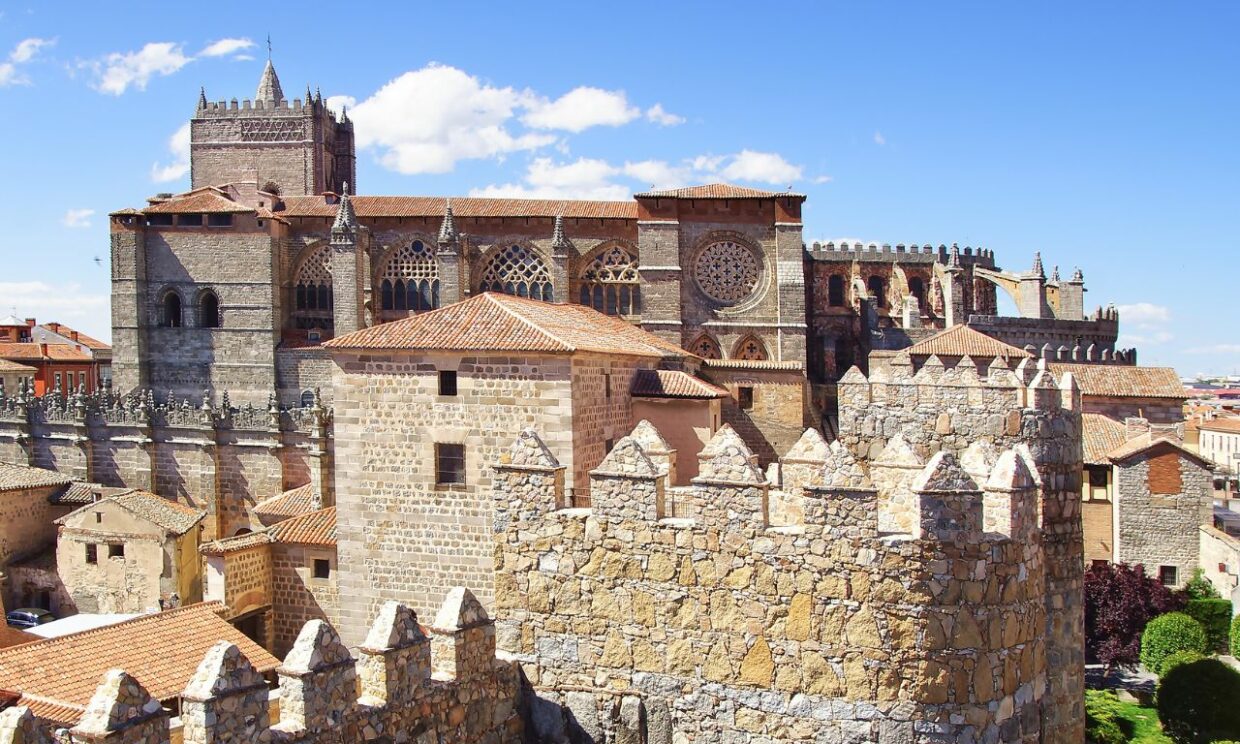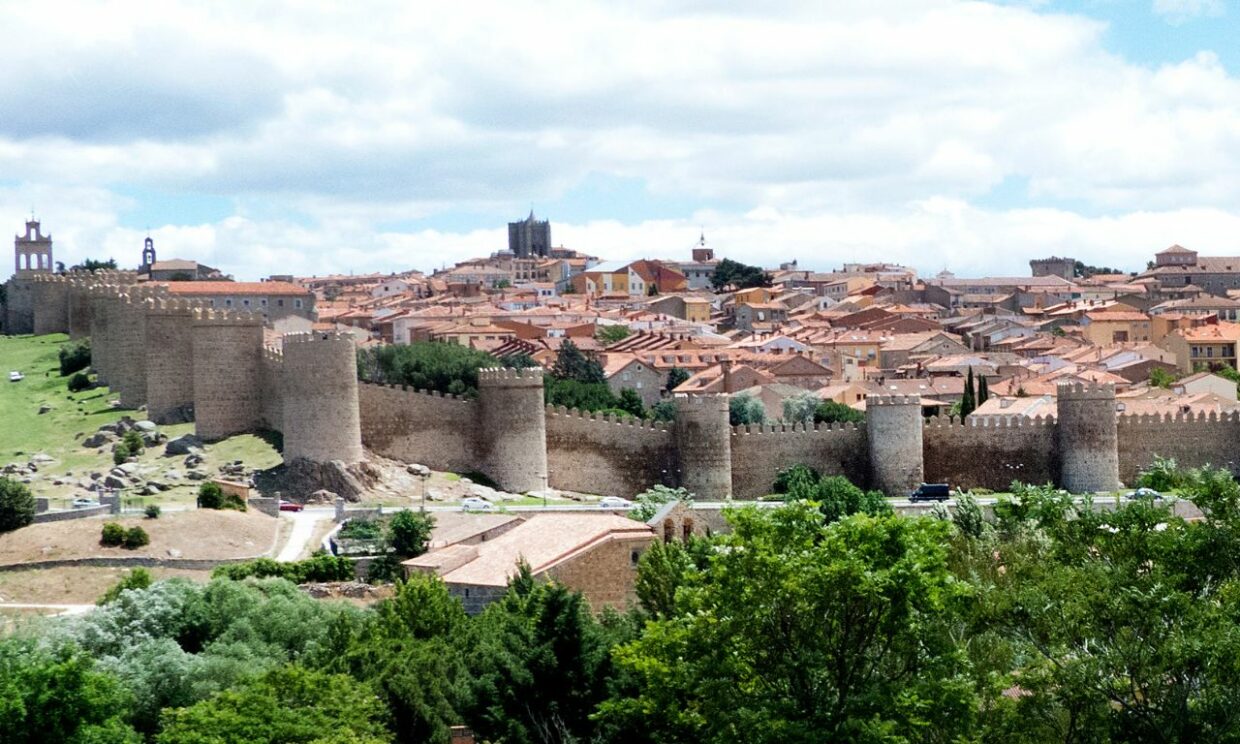Are you looking for a unique day trip experience that is just a short side trip from Madrid? Look no further! Avila, known as “The City of Stones and Saints”, is the perfect day trip destination. This historic city was declared a UNESCO World Heritage Site in 1985, owing to its well-preserved walls and monuments from the Middle Ages.
When I visited Avila, I was transported back in time to explore a captivating walled city with rich history, culture, and spirituality. From its romanesque churches to its majestic walls that encircle the city center, there is something everyone can enjoy on this day trip from Madrid.
Coming your way in this post - click to expand ->
Note – Please know, some of the external links on this page are affiliate links, this means that if you purchase after following one, I make a small commission from the sale at no additional cost to yourself.
Keep reading to find out what you can expect when visiting Avila, but first …
Is Avila Worth Visiting?
Absolutely! Avila is a beautiful city with loads of attractions to explore. Whether you’re looking for historic monuments, stunning landscapes, or delicious local cuisine, it has something for everyone.
Its old town center is renowned for its well-preserved medieval city walls and many churches, monasteries, and palaces such as the Avila Cathedral and the Royal Monastery of Saint Thomas.
These monuments are excellent examples of Spanish architecture, and many are World Heritage sites. So, if you’re looking for a destination with plenty to see, an Avila day trip is definitely worth considering.
Where is Avila Located – What Makes It A Popular Destination

Avila is located in the autonomous community of Castile and Leon, northwest of Madrid. It is most known for its medieval walls, which are some of the most spectacular and well-preserved in Europe.
These walls were built between the 11th and 14th centuries to protect the city from Moorish attacks. The wall itself is some 2,500 meters (1.5 miles) long and 12 meters (40 feet) high and is made up of 9 gates and 88 towers.
Inside these old city walls lies Avila’s old quarter, a treasure trove of Romanesque, Gothic, and Renaissance architecture. Here you can explore cobblestone streets lined with historic buildings, churches, and palaces dating back hundreds of years.
The magnificent Sierra de Gredos mountain range serves as the perfect backdrop to this charming city. With its breathtaking landscapes, unique architecture, and rich cultural heritage, Avila makes for an ideal day trip destination from Madrid.
Need a visa?
Not sure if you need a visa to visit this country? Use this nifty little tool from iVisa to check the requirements as well as lots more useful information for your trip.
How To Get To Avila From Madrid
Located around 108 kilometers away, a day trip to Avila From Madrid is an easy option. Here are some best ways to get to Avila from Madrid to enjoy your travels stress-free!
Madrid To Avila By Train
The train route from Madrid to Avila is a popular one, with several daily departures. The journey takes approximately 1 hour and 30 minutes each way and costs around €20 for a return ticket, although this will vary depending on time and availability.
Click here to check the latest train times and prices.
The are two main stations on the route and Madrid Príncipe Pio and Avila Railway Station. It is possible to get a train from Madrid Chamartin Station to Avila. However, there are more regular and faster trains from Príncipe Pio station.
It’s not a high-speed train service, so you can expect to travel through several small towns and villages before arriving in Avila. The typical stops along this route include Aranjuez, Navalcarnero, El Tiemblo, and Hoyorredondo, among others. The journey from Madrid to Avila is fairly quick and scenic, with trains arriving in Avila at the station located near the old town.
Madrid To Avila By Car

If you haven’t driven in Spain before, brush up on the Spanish driving laws first.
There are a couple of options if you fancy hiring a car and driving. The fastest would be the motorway. Take the AP6, then the AP51 (toll roads), and you’ll be there in a little over an hour and 15 minutes.
However, to get from Madrid to Avila by car, I’d recommend a more scenic route. Take the M-501 towards San Martín de Valdeiglesias, followed by the N-403 up to Avila. The journey should take around 1 hour and 45 minutes, depending on traffic, and along the route from Madrid to Avila, there are several stops of interest where you can take a break from driving and explore the area. The town of El Tiemblo is home to a castle, which dates back to the 11th century and is now open to the public for tours, and if you have kids, they’d love a stop at the Enchanted Forest!
Madrid To Avila By Bus
The cheapest way to get from Madrid to Avila is by bus, it costs just €16 return. The bus journey takes approximately 1 hour and 15 minutes and several bus routes go from Madrid to Avila. The most convenient route is the ALSA bus, which departs from the main Madrid Bus Station and stops in Avila. The ALSA bus has comfortable seating and air conditioning, making it a great option for traveling between Madrid and Avila.
Enjoy An Orgnised Tour
While certainly the most expensive option, an organised tour to Avila from Madrid as a day trip is an ideal choice for those looking for convenience and a hassle-free journey. With hotel pick up and drop off, taking the worry out of having to be at a train station or bus stop on time, it’s perfect for anyone who wants to make their experience effortless.
Plus, with a guided tour available, you can explore the historic town knowing that someone with local knowledge is showing you around.
There are a number of tours available; some even include a visit to Segovia as well. I have highlighted a few recommended tours below, or click here to see more options.
What To Do In Avila – Top Attractions And Activities
Avila, Spain is a city rich in culture and historical significance. With stunning architecture and delicious food, there is something for everyone to enjoy.
If you’re not visiting as part of an organised tour, you may want to consider booking a free walking tour of Ávila. It’s always a great way to start any city visit. Click here for more information about that, but if you prefer self serve touristing, I have compiled a list of some of Avila’s top attractions and activities. Here are some of the must see sights.
La Muralla de Ávila (Town Walls)

The ancient walls of Ávila are a must-see if you’re planning a day trip to the city. The walls, which were built between 1090 and 1099 as a defense against the Moors, are among the best preserved in Spain and offer an impressive sight. The circuit of the walls extends 2,557 meters with an average height of 12 meters, giving visitors an exciting view from atop its parapets.
There are nine gates into the city, two of which incorporate repurposed Roman-era stones – Puerta de San Vicente and Puerta del Alcázar – to provide further historical depth. A particular highlight is Ciborro, the cathedral’s tower which offers splendid views as well as forming part of the town’s defenses. Visitors can begin a self-guided walking tour at the Puerta del Carmen gate and enjoy taking steps up to a walking path on top of these impressive walls.
Avila Cathedral

The imposing gothic architecture and its fortresses and turrets make it an unforgettable sight. When you enter the cathedral, you will be surrounded by soaring pillars and stunning stained glass windows that keep the area bright and illuminated.
The atmosphere inside Avila Cathedral is one of tranquillity, awe and contemplation: from the majestic 12th-century entrance (which was moved to the north wall in the 15th century), to its intricate wall sculptures, paintings and statues which grace every corner.
Its main altar has been spared despite years of wars and fires. It’s also worth checking out some unique artifacts, including several pieces taken from Jerusalem during the Crusades in 1212 as well as a holy relic – a mortar that served as a reminder to those who perished in an earthquake in 1698. All these features are beautiful reminders of both Spain’s past and present, making them popular among locals and tourists alike.
The Basilica of San Vicente

The basilica’s exterior is captivating, with two towers on the west façade, an impressive doorway considered one of the best in Spain, and a high granite portico on the south façade. Inside are three naves divided by six pairs of enormous pillars adorned by semi-columns. The central nave being much taller than the lateral ones creates an awe-inspiring atmosphere for visitors.
Scattered throughout different parts of church there are several altarpieces that enhance its beauty. The transept houses a tomb dedicated to martyred brothers Vicente, Sabina & Cristeta in honor of them who contributed significantly to this sacred place centuries ago.
The Church and Convent of St. Teresa

Built on the site where Saint Teresa de Cepeda y Ahumada was born, the Convento de Santa Teresa is a Baroque-style church opened its doors in 1636. The interior of this magnificent building has a Latin-cross plan with a central nave and four chapels on each side. Its main altar is located in the northwest corner, a unique feature which does not conform to liturgical orientation but rather pays tribute to its founding saint.
Apart from admiring the architectural beauty of its grandiose structure, visitors can explore the museum within the convent, which showcases ancient art pieces connected to Teresa’s life and artifacts from some of her other family members, who lived in this area centuries ago.
In addition to exploring all these fascinating features within the convent, you can also enjoy amazing views over Avila’s old quarters or take a leisurely walk around its peaceful cloister gardens.
The Four Pillars

The Shrine of San Sebastian is situated on the left bank of the Adaja River in Avila. Also known locally as Los Cuatro Postes (The Four Pillars), it is a special site that provides spectacular views of the walled city.
It was built in 1566 on a site that is believed to have been a Roman template in the past. Historians also believe it commemorates the location where Teresa de Jesús’ uncle, Francisco de Cepeda, reunited with her and her brother Rodrigo as they fled as martyrs to Moorish territories.
Just bear in mind this isn’t walkable. During my visit, I got here as part of a ride on a tourist train. Yep, the older I get, the more I embrace those annoying little trains.
Cool idea alert: How about a short flight over the walls of Ávila for a once-in-a-lifetime experience? Click here for more information
Where To Eat In Avila – The Best Restaurants And Cafes
Avila is a beautiful and historic city in Spain. It has a wide range of restaurants, cafés, tapas bars, and pastry shops to suit all tastes and budgets. Here are some of the best places to eat in Avila.
- El Rincón del Salero: EI Rincon del Salero tiny tapas bar located in a narrow alley near the city center has some of the most delicious tapas around. It offers a selection of traditional and modern dishes including yemas de santa teresa and chuletón de ávila that are served quickly and expertly.
- Mesón de La Catedral: Meson de La Catedral is an upscale restaurant located in the heart of Avila’s old quarter. It features classic Spanish cuisine as well as some international dishes, all served with a touch of elegance.
Yemas de Ávila
Yemas de Santa Teresa, also known as Yemas de Ávila, is a traditional Spanish pastry from Ávila. It is made with egg yolks and a syrup reduction composed mainly of lemon juice, cinnamon. The egg yolks are carefully stirred in copper bowls until they reach a creamy consistency.
Then, the syrup is cooked until it reaches a sticky consistency and mixed with the egg yolks. Finally, the mixture is left to cool down before being moulded into small spheres or pyramids that can be half-covered in sugar. The delicacy has become so popular that it can be found across Spain and it is often given as souvenirs from Ávila for its unique flavor.
If you are a bit of a foodie, you may want to try this workshop to make your own Yemas de Ávila
What To Bring With You To Visit Avila
When packing for your day trip to Avila, there are a few essentials you will want to be sure to bring.
- First, you should wear light layers of clothing such as jeans and sweaters. Even though Avila is known for its sunny climate, the temperatures can drop quickly in the evenings due to its mountain location.
- A comfortable pair of shoes is also key. Avila is a historically significant city with plenty of narrow cobblestone streets that can be slippery when wet. Make sure to wear good walking shoes with a solid grip that won’t slip or slide on the stones.
- In addition, make sure also to bring a hat, sunglasses, and sunscreen to protect you from the sun’s rays. Avila is located in an area known for its intense heat during the summer months.
- Finally, don’t forget to bring your camera and some snacks so you can capture all of the beautiful sights! Snacks will help keep you energized while exploring the city
Final thoughts on an Avila day trip
Avila is a stunning city filled with historical monuments, amazing landscapes, and delicious local cuisine. Whether you’re looking for an outdoor adventure or simply want to explore the city’s rich history, 1 day in Avila the walled city, has something for everyone. You can visit Puerta de san Vicente, la casa del Presidente, basilica de san Vicente, alcazar de Avila and plaza del mercado chico.
So what are you waiting for? Pack your bag and prepare for the Avila day trip to experience. It’s a must-see attraction for those interested in medieval history or architecture and anyone looking for a unique way to explore the Avila province. You won’t regret it!
